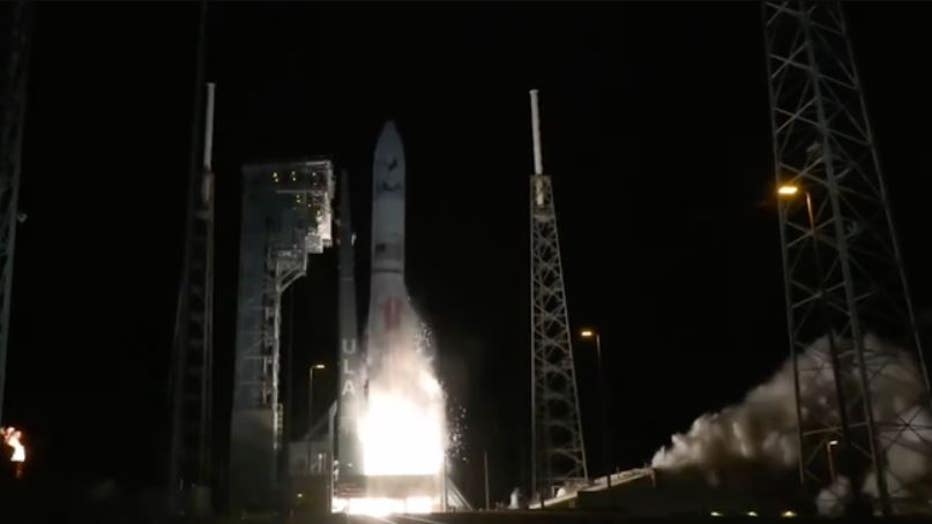'No chance of' Moon landing for Peregrine lander after mission-critical spaceflight issues

A United Launch Alliance (ULA) Vulcan VC2S rocket launched the first certification mission from Space Launch Complex-41 at Cape Canaveral Space Force Station, Florida on Jan. 8, 2024 at 2:18 a.m. ET. Photo credit: United Launch Alliance (ULA)
Early Monday, private space company Astrobotic celebrated the launch of its Peregrine Moon lander. However, hours after liftoff, the journey to the lunar surface began to go awry, and the company said a lunar landing was no longer possible.
Peregrine's spaceflight began Monday just after 2 a.m. EST with the first launch of United Launch Alliance's Vulcan rocket from Cape Canaveral, Florida. The liftoff marked the first mission as part of NASA's Commercial Lunar Payload Services (CLPS) program and the inaugural launch of ULA's new rocket.
FIRST VULCAN ROCKET LAUNCH SENDS AMERICAN MOON LANDER ON JOURNEY TO LUNAR SURFACE
The Peregrine lander and spacecraft carries 20 payloads from customers worldwide, including five NASA science missions designed to prepare for the Artemis astronaut landings next year.
Hours into the spaceflight, mission control at Astrobotic's headquarters in Pittsburgh was faced with its first mission-critical issue, threatening the Moon landing attempt planned for Feb. 23.
"Unfortunately, an anomaly occurred, which prevented Astrobotic from achieving a stable sun-pointing orientation," Astrobotic said in a statement.
The Peregrine spacecraft needs sunlight to maintain power. The team quickly improvised a maneuver to reorient the solar panels toward the Sun.
With one issue fixed and Peregrine's batteries at full charge, Astrobotic engineers worked to determine the root cause of the problem. The company said they believe a failure in the propulsion system caused a "critical loss of propellant."
The first photo from Peregrine in space showed damage to the multi-layer insulation on the spacecraft, confirming an issue with the propulsion system.

ULA's Vulcan rocket launches from Cape Canaveral, Florida on Jan. 8 sending the Astrobotic Peregrine lander to the lunar surface. (Image: ULA)
"Given the propellant leak, there is, unfortunately, no chance of a soft landing on the Moon. However, we do still have enough propellant to continue to operate the vehicle as a spacecraft," Astrobotic said on Tuesday.
Astrobotic said the new goal is to get Peregrine as close to lunar distance as possible before it loses power and the ability to maintain a sun-pointing position.
The engineering team estimates the spacecraft could continue to operate for about 40 more hours.
"The team continues to work to find ways to extend Peregrine's operational life," the company said. "We are in stable operating mode and are working payload and spacecraft tests and checkouts."
HUMAN ASHES, PET HAIR AMONG ITEMS HEADED TO MOON ON MONDAY LAUNCH
If Peregrine had completed the 238,000-mile journey and successfully landed on the Moon, it would have been the first commercial lunar landing.
Astrobotic was among the 14 private companies selected under NASA’s CLPS initiative to deliver science to the Moon ahead of the first Artemis astronaut missions to the lunar south pole in late 2025. Next month, another NASA CLPS contractor, Houston-based company Intuitive Machines, will launch its moon lander with SpaceX.
NASA said copies of four payloads on Peregrine will fly on future Moon missions.
"There are many challenges with spaceflight, and we’re incredibly proud of the Astrobotic and NASA teams that have put us one step closer to a robotic return to the lunar surface as part of Artemis. This delivery service model is a first for the agency and with something new, there is a higher risk," said Joel Kearns, deputy associate administrator for exploration at NASA’s Science Mission Directorate. "NASA is committed to supporting our commercial vendors as they navigate the very difficult task of sending science and technology to the surface of the Moon."
Astrobotic is already at work on its second robotic Moon mission.

